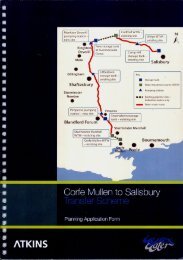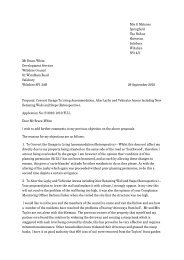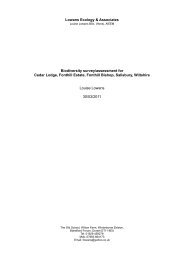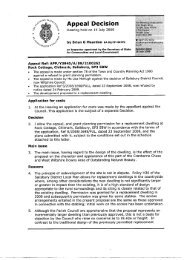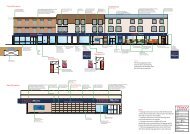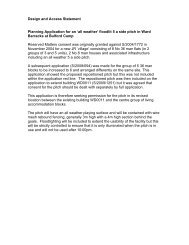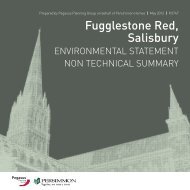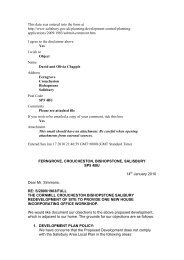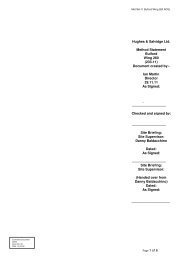English Heritage Stonehenge Environmental Improvements Project ...
English Heritage Stonehenge Environmental Improvements Project ...
English Heritage Stonehenge Environmental Improvements Project ...
You also want an ePaper? Increase the reach of your titles
YUMPU automatically turns print PDFs into web optimized ePapers that Google loves.
<strong>English</strong> <strong>Heritage</strong><br />
<strong>Stonehenge</strong> <strong>Environmental</strong> <strong>Improvements</strong><br />
<strong>Project</strong><br />
Phase II Botanical Surveys<br />
September 2008
September 2008<br />
11108605R_Botanical_DW_09-08<br />
Phase II Botanical Surveys<br />
Chris Blandford Associates
September 2008<br />
11108605R_Botanical_DW_09-08<br />
Phase II Botanical Surveys<br />
Chris Blandford Associates
CONTENTS<br />
SUMMARY<br />
1.0 INTRODUCTION<br />
2.0 METHODOLOGY<br />
3.0 RESULTS<br />
4.0 EVALUATION<br />
TABLES<br />
1. Criteria used in evaluating the relative botanical importance of habitats<br />
2. Results of the evaluation process for Site V<br />
3. Results of the evaluation process for Site W<br />
4. Results of the evaluation process for Site X<br />
5. Results of the evaluation process for Site Y<br />
6. Results of the evaluation process for Site Z<br />
FIGURES<br />
1.1 Location of Sites and Areas Surveyed Within Sites<br />
APPENDICES<br />
A. Botanical survey results, site V<br />
B. Botanical survey results, site W<br />
C. Botanical survey results, site X<br />
D. Botanical survey results, site Y<br />
E. Botanical survey results, site Z<br />
September 2008<br />
11108605R_Botanical_DW_09-08<br />
Phase II Botanical Surveys<br />
Chris Blandford Associates
September 2008<br />
11108605R_Botanical_DW_09-08<br />
Phase II Botanical Surveys<br />
Chris Blandford Associates
SUMMARY<br />
A botanical survey was undertaken of targeted habitats within the shortlisted site options for new visitor<br />
facilities, currently being considered for the <strong>Stonehenge</strong> <strong>Environmental</strong> <strong>Improvements</strong> <strong>Project</strong>. The aims<br />
of the survey were to identify the plant species and communities present and to evaluate these in relation<br />
to their nature conservation importance.<br />
The survey identified species and communities of arable fields, improved and semi-improved grassland,<br />
unimproved calcareous grassland, scrub and coniferous and broadleaved plantations. The areas of<br />
greatest value for nature conservation in terms of their flora were areas of unimproved calcareous<br />
grassland within sites W, X and Z, which were evaluated to be of local (W and X) and international (Z)<br />
importance. However, other areas also had some value, for example unimproved or semi-improved<br />
calcareous grassland at sites W and Z, old broadleaved plantation at site X and arable fields that support<br />
an uncommon arable weed species at sites X and Z.<br />
September 2008<br />
11108605R_Botanical_DW_09-08<br />
Phase II Botanical Surveys<br />
Chris Blandford Associates
September 2008<br />
11108605R_Botanical_DW_09-08<br />
Phase II Botanical Surveys<br />
Chris Blandford Associates
1.0 INTRODUCTION<br />
1.1 Purpose of the Survey<br />
1.1.1 This report sets out the results of a botanical survey for the <strong>Stonehenge</strong> <strong>Environmental</strong><br />
<strong>Improvements</strong> <strong>Project</strong>. The purpose of this study is to inform a baseline against which the<br />
effects of development options and proposals can be assessed in relation to impacts on<br />
ecological and nature conservation resources..<br />
1.1.2 The scope of the study includes:<br />
• Identification of plant species and communities present within and around shortlisted site<br />
option Appraisal Areas; and<br />
• Evaluation of the identified plant species and communities in relation to their nature<br />
conservation importance.<br />
1.2 Study Area<br />
1.2.1 The Study Areas within and around the shortlisted site options for new visitor facilities 1 chosen<br />
for the purposes of the botanical surveys are shown on Figure 1.1.<br />
1<br />
The Future of <strong>Stonehenge</strong> – Public Consultation (<strong>English</strong> <strong>Heritage</strong>, July 2008)<br />
September 2008 1 Phase II Botanical Surveys<br />
11108605R_Botanical_DW_09-08<br />
Chris Blandford Associates
2.0 METHODOLOGY<br />
2.1 Field Survey<br />
2.1.1 Botanical surveys were carried out from May to July 2008, and the methodologies used are<br />
described below. The locations of sites and parts of sites are illustrated in Figure 1.1.<br />
2.1.2 Nomenclature for plant species follows Stace 2 , except where this differed within National<br />
Vegetation Classification community names 3 .<br />
2.1.3 In each area surveyed, all species identified were recorded and a broad indication of their<br />
frequency and abundance was given using the DAFOR scale. In addition, in many areas, a<br />
quadrat or quadrats of a size appropriate to the habitat or community (in accordance with<br />
guidelines set out in the ‘National Vegetation Classification: Users Handbook’ 4 ) were placed in<br />
homogenous and representative stands of the different vegetation types present. The species<br />
present within the quadrat(s), and their abundance, were recorded using the DOMIN scale.<br />
Notes were also taken of the general features of the area, its appearance and structure. Where<br />
possible the plant communities present have been referred to the most appropriate National<br />
Vegetation Classification (NVC) community 2 .<br />
2.2 Evaluation<br />
2.2.1 Habitats and communities were evaluated using a combination of criteria, guidance and<br />
frameworks, such as those outlined by Ratcliffe 5 , including size, diversity, naturalness, rarity,<br />
geographical position and fragility, the criteria for the selection of sites for SSSI designation 6 ,<br />
criteria for the selection of County Wildlife Sites in Wiltshire 7 , criteria for the selection of<br />
Important Arable Plant Areas 8 and Wiltshire Habitat Action Plans 9 . Further detail regarding the<br />
criteria used in evaluating habitats within the site is provided in Table 1.<br />
2.2.2 Species were evaluated using the red data list for vascular plant species 10 , Scarce Plants in<br />
Britain.<br />
2<br />
Stace C. 1997 New Flora of the British Isles second edition. Cambridge University Press.<br />
3<br />
Rodwell, J.S. (ed) et al 1991-2000. British Plant Communities Volumes 1-5. Cambridge University Press.<br />
4<br />
Rodwell J.S. 2006 National Vegetation Classification: Users Handbook. JNCC<br />
5<br />
Ratcliffe, D., 1977. A Nature Conservation Review, Volume 1. Cambridge University Press.<br />
6<br />
Nature Conservancy Council , 1989. Guidelines for selection of biological SSSIs. Nature Conservancy Council.<br />
7<br />
Wiltshire and Swindon Biological Record Centre, 2004. The County Wildlife Sites <strong>Project</strong>: Criteria for site selection, 3 rd draft.<br />
Wiltshire and Swindon Biological Record Centre,<br />
8<br />
Byfield, A. and Wilson, P. (2005). Important Arable Plant Areas: Identifying priority sites for arable plant conservation in the<br />
United Kingdom. Plantlife International, Salisbury, UK.<br />
9<br />
Wilkinson, S. (ed) 2008. Wiltshire Biodiversity Action Plan. Wiltshire Biodiversity Action Plan Steering Group.<br />
10<br />
Cheffings, C.M. and Farrel, L. (eds.), 2005. The Vascular Plants Red Data List for Great Britain. JNCC.<br />
September 2008 2 Phase II Botanical Surveys<br />
11108605R_Botanical_DW_09-08<br />
Chris Blandford Associates
Table 1 Criteria used in evaluating the relative botanical importance of habitats<br />
Value<br />
Examples of Evaluation Criteria<br />
International Importance • High importance and rarity, international scale and limited potential for<br />
substitution;<br />
• A internationally designated site (Special Area of Conservation SAC, Special<br />
Protection Areas SPA);<br />
• Presence of Internationally rare species;<br />
• Woodland: Semi-Natural Ancient Woodland greater than 20ha including a<br />
combination of type stands;<br />
• Grassland: Unimproved and species-rich grassland greater than 0.5 ha including<br />
internationally rare habitats;<br />
• Arable sites with threshold scores of more than 90 points 11 .<br />
National Importance • High importance and rarity, national scale, or regional scale with limited<br />
potential for substitution;<br />
• A nationally designated site (Sites of Special Scientific Interest (SSSIs), National<br />
Nature Reserves (NNRs) etc.;<br />
• A viable area of a priority habitat identified in the UK BAP, or of smaller areas of<br />
such habitat which are essential to maintain the viability of a larger whole;<br />
• Woodland: Semi-Natural Ancient Woodland greater than 5ha;<br />
• Grassland: Unimproved grassland greater than 10 hectares; over 10 positive or<br />
unimproved grassland indicators;<br />
• Arable sites with threshold scores of 45-89 points.<br />
Regional Importance • High or medium importance and rarity, local or regional scale, and limited<br />
potential for substitution.<br />
• Any regularly occurring, locally significant population of a Nationally Scarce<br />
species (occurs in between 16 to 100 10km squares of the national grid) or in a<br />
Regional BAP or relevant Natural Area on account of its regional rarity or<br />
localisation; or<br />
• Woodland: Semi-Natural Ancient Woodland between 2 and 5ha;<br />
• Grassland: Unimproved grassland greater than 0.5 hectares, over 10 positive or<br />
unimproved grassland indicators.<br />
County Importance • High or medium importance and rarity, local or regional scale, and limited<br />
potential for substitution. A site designated as being of County Importance i.e.<br />
County Wildlife Site (CWS);<br />
• A viable area of Key Habitat identified in the County BAP;<br />
• Any regularly occurring locally significant population of a species which is listed<br />
in a County Red Data Book, BAP or County Rare Plant Register on account of its<br />
regional rarity or localisation;<br />
• A regularly occurring locally significant number of a County important species;<br />
• Woodland: Semi-Natural Ancient Woodland greater than 0.25 ha with 10 or<br />
more AWIS;<br />
• Grassland: Unimproved grassland greater than 0.5 hectare with 6 positive or<br />
unimproved grassland indicators;<br />
• Arable sites with threshold scores of 30-44 points. Vascular ;<br />
• Plants: According to KWT 2005 12 , >150 points (locally scarce or rare in County<br />
= 25 points).<br />
11<br />
Byfield, A. and Wilson, P. (2005). Important Arable Plant Areas: Identifying priority sites for arable plant conservation in the<br />
United Kingdom. Plantlife International, Salisbury, UK.<br />
12<br />
Kent Wildlife Trust, 2005 Local Wildlife Sites in Kent Criteria for Selection and Delineation. Kent Wildlife Trust.<br />
September 2008 3 Phase II Botanical Surveys<br />
11108605R_Botanical_DW_09-08<br />
Chris Blandford Associates
Value<br />
Examples of Evaluation Criteria<br />
Local Importance • Low or medium importance and rarity, local scale;<br />
• A site designated as being of Local Importance by Oxford City Council i.e. a Site<br />
of Local Interest of Nature Conservation (SLINC);<br />
• Any regularly occurring, locally significant population of a species listed as being<br />
Locally Scarce which occurs in 100-500 10km squares in the UK;<br />
• Areas of habitat identified as being of Local Value in the relevant Natural Area<br />
profile;<br />
• Woodland: Semi-Natural Ancient Woodland/ Mature plantation smaller than<br />
0.25 ha with 3 or more AWIS;<br />
• Grassland: Unimproved or rich semi-improved grassland greater than 0.5 hectare<br />
with 3-4 unimproved grassland indicators;<br />
• Vascular Plants: According to KWT 2005, >100 points (locally scarce or rare in<br />
County = 25 points);<br />
Parish Importance • Low or medium importance and rarity, local scale;<br />
• Areas of habitat considered to appreciably enrich the habitat resource within the<br />
context of the Parish or Neighbourhood e.g. species-rich hedgerows/ or adjacent<br />
to habitat of County Value or above;<br />
• Area of woodland with 2 or more AWIS species, or >0.25ha of mature<br />
plantation/semi-natural woodland;<br />
• 1-3 unimproved grassland indicators;<br />
• Vascular Plants: According to KWT 2005, >50 points (locally scarce or rare in<br />
County = 25 points).<br />
Negligible Importance • Very low importance and rarity, local scale;<br />
• Sites or areas, which support few or no habitats, communities or species<br />
populations of nature conservation interest.<br />
September 2008 4 Phase II Botanical Surveys<br />
11108605R_Botanical_DW_09-08<br />
Chris Blandford Associates
3.0 RESULTS<br />
3.1 General<br />
3.1.1 The locations of sites and parts of sites are illustrated in Figure 1.1. Appendices A-E summarise<br />
the results of the botanical survey for sites V to Z respectively.<br />
3.2 Site V<br />
3.2.1 The southern part of Site V comprises the existing car parking areas for <strong>Stonehenge</strong> (Appendix<br />
A, S). The southern part of this is largely under hard standing but verges and banks of speciespoor<br />
amenity grassland are present. These are dominated by perennial rye-grass Lolium<br />
perenne and a small number of other common species of such grasslands, such as daisy Bellis<br />
perennis Dandelion Taraxacum officinale agg. and white clover Trifloium repens, and is<br />
referable to the NVC community MG7 Lolium perenne-Trifolium repens perennial rye-grasswhite<br />
clover grassland. Shrubs, mostly hawthorn Crataegus monogyna are also present in some<br />
of the grassland. The northern part of the car park has larger areas of species-poor amenity<br />
grassland very similar to that in the southern part.<br />
3.2.2 Immediately to the north of the car park is a pasture of poor semi-improved grassland<br />
(Appendix A, N), which supports a range of grass species and a small number of common<br />
grassland herbs.<br />
3.3 Site W<br />
Arable<br />
3.3.1 E 3 is an arable field. The arable weed flora is very species-poor and sparse throughout the<br />
majority of the field, although localised patches with a more species-rich and abundant<br />
community are present on some of the margins and corners, particularly the south west corner<br />
(where the quadrat was located). This supports a range of common arable weed species, such<br />
as barren brome Anisantha sterilis, common mouse-ear Cerastium fontanum, common poppy<br />
Papaver rhoeas, field pansy Viola arvensis and field speedwell Veronica persica, and is best<br />
referred to the NVC community OV3 Papaver rhoeas-Viola arvensis common poppy-field pansy<br />
community.<br />
September 2008 5 Phase II Botanical Surveys<br />
11108605R_Botanical_DW_09-08<br />
Chris Blandford Associates
Grassland<br />
3.3.2 W3 is a species-poor improved or semi-improved pasture supporting a limited range of<br />
common grassland species that is referable to the NVC community MG6 Lolium perenne-<br />
Cynosorus cristatus perennial rye-grass-crested dog’s-tail grassland.<br />
3.3.3 E1 forms the banks of the track that bisects the Site from north to south. Although of variable<br />
species-richness they consist of coarse-grained unimproved calcareous grassland dominated by<br />
upright brome Bromopsis erecta, referable to the NVC community CG3 Bromus erectus upright<br />
brome grassland, and which is typical of low levels of grazing or cutting. Other species present<br />
that are characteristic of such grasslands include bird’s-foot trefoil Lotus corniculatus, greater<br />
knapweed Centaurea scabiosa and the Red Data Book Near Threatened species sanfoin<br />
Onobrychis vicifolia.<br />
3.3.4 E4 is a small species poor pasture referable to the NVC community MG7 Lolium perenne-<br />
Trifolium repens perennial rye-grass-white clover grassland.<br />
Plantations<br />
3.3.5 W1, W2 and E2 are coniferous plantations that are very similar in species composition. The<br />
canopy is dominated by Scot’s pine Pinus sylvestris and the shrub layer is variable in density,<br />
with hawthorn and elder Sambucus nigra the most common species. The field layer is speciespoor<br />
and quite grassy in places, although bramble Rubus fruticosus agg. is patchily abundant.<br />
The field layer includes very few characteristic woodland species. The woodland as a whole is<br />
not referable to an NVC community, although the shrub layer could be referred to W21<br />
Crataegus monogyna-Hedera helix hawthorn-ivy scrub.<br />
3.4 Site X<br />
Road verges<br />
3.4.1 The verges of the A344 comprise of relatively species-poor grassland dominated by false oatgrass<br />
Arrhernatherum elatius, referable to the NVC community MG1 Arrhernatherum elatius<br />
false oat-grass grassland.<br />
South Western Quadrant<br />
3.4.2 SW1 is a small area of species-rich unimproved calcareous grassland referable to the NVC<br />
community CG2 Festuca ovina-Avenula pratensis sheep’s fescue-meadow oat grass grassland. It<br />
September 2008 6 Phase II Botanical Surveys<br />
11108605R_Botanical_DW_09-08<br />
Chris Blandford Associates
supports a good range of characteristic species, including sheeps fescue Festuca ovina, upright<br />
brome, crested harir-grass Koeleria macrantha, meadow oat-grass Helictotrichon pratensis,<br />
dwarf thistle, Cirsium acaule, horseshoe vetch Hippocrepis comosa, salad burnet Sanguisorbia<br />
minor and common thyme Thymus polytrichus. It appears to be maintained by relatively heavy<br />
rabbit grazing, and this is reflected in the relatively high frequency of common ragwort Senecio<br />
jacobea and the presence of the Red Data Book Near Threatened species hounds-tongue<br />
Cynoglossum officinale. Scrub is present around the edges of the grassland, which includes<br />
hawthorn, wild privet Ligustrum vulgare, buckthorn Rhamnus catharticus and elder.<br />
3.4.3 SW2 is species-poor improved grassland (NVC MG7) dominated by a very small number of<br />
common grasses and herbs, such as soft brome Bromus hordaceous, perennial rye-grass, white<br />
clover and dandelion.<br />
South Eastern Quadrant<br />
3.4.4 SE1 is a developing broadleaved plantation that forms a southern extension of the Fargo<br />
Pantation. It has a canopy dominated by sycamore Acer pseudoplatanus, although beech Fagus<br />
sylvatica and ash Fraxinus excelsior are also present. Except on the edges there is little in the<br />
way of a shrub layer, although elder is locally abundant in the centre (and appears likely to<br />
pre-date the plantation). The field layer is species-poor with very few characteristic woodland<br />
species, and is patchily dominated by, for example, rough-meadow grass Poa trivialis and nettle<br />
Urtica dioica.<br />
3.4.5 SE2 is an area of developing grassland on an ex-arable field. The sward is patchy, with frequent<br />
bare patches which support a range of common arable weed species. Sheep’s fescue and<br />
upright brome are the most common grass species, with sanfoin, ribwort plantain Plantago<br />
lanceolata and white clover. With time this grassland may develop into CG2 or CG3 grassland,<br />
although many of the characteristic species are not currently present.<br />
North Eastern Quadrant<br />
3.4.6 NE1 is a plantation, of which the southern part has a canopy dominated by sycamore and ash.<br />
The shrub layer is variable in density with hazel Corylus avellana the most abundant species.<br />
The field layer is moderately species-rich and supports a number of woodland species such as<br />
wood speedwell Veronica montana and dog violet Viola riviniana. Although it is likely that this<br />
area was originally a plantation, it has now developed a relatively semi-natural structure and<br />
can be considered a relatively species-poor example of the NVC community W8 Fraxinus<br />
excelsior-Acer campestre-Mercurailis perennis ash-field maple-dog’s mercury woodland.<br />
September 2008 7 Phase II Botanical Surveys<br />
11108605R_Botanical_DW_09-08<br />
Chris Blandford Associates
3.4.7 The northern part of NE1 is broadly similar in species composition, although (rather sickly<br />
looking) pine Pinus sp. forms an abundant component of the canopy here.<br />
3.4.8 NE2 is an area of relatively species-poor grassland that has developed on an area previously<br />
occupied by part of the Fargo Plantation.<br />
North Western Quadrant<br />
3.4.9 NW1 includes a number of different habitats and communities. The south western part is<br />
unimproved calcareous grassland very similar to that within SE1 on the southern side of the<br />
A344. The tumulus in the north eastern part supports species-poor grassland dominated by<br />
false oat-grass, and scrub is present in the north western corner and along the southern edge.<br />
3.4.10 NW2 is an arable field in which the arable weed flora is generally sparse and species-poor,<br />
although this is more abundant and species-rich on the margins and in corners. Here a range of<br />
common arable weed species are present, of which field speedwell, field forget-me-not<br />
Myosotis arvensis, cut-leaved crane’s-bill Geranium dissectum and field pansy are<br />
conspicuous. Of note is the presence of a small number of plants of the Red Data Book Near<br />
Threatened species dwarf spurge Euphorbia exigua. The community is best referred to the NVC<br />
community OV15 Anagallis arvensis-Veronica persica scarlet pimpernel-field speedwell<br />
community.<br />
3.5 Site Y<br />
Road Verges<br />
3.5.1 Grassy road verges (C) are present on either side of both the A344/A360/B3086. These are<br />
relatively similar in structure and species composition throughout. They are mostly speciespoor<br />
and dominated by false oat-grass. However, some areas, particularly where false oat-grass<br />
is less abundant, are more species-rich, including a number of species characteristic of<br />
unimproved calcareous grasslands, such as upright brome, common knapweed and burnet<br />
saxifrage Pimpinella saxifraga. These grasslands can be referred to the NVC community MG1<br />
Arrhernatherum elatius false oat-grass grassland. Small plantations of beech are present on the<br />
northern side of the A344, either side of the Airman’s Corner junction.<br />
North Western and South Western Quadrants<br />
3.5.2 NW and SW are arable fields. At the time of survey the crop in NW was at a relatively early<br />
stage of development so the arable weed flora was distributed more or less throughout the<br />
September 2008 8 Phase II Botanical Surveys<br />
11108605R_Botanical_DW_09-08<br />
Chris Blandford Associates
field. It comprised a range of typical arable weed species, including black bindweed Fallopia<br />
convulvulus, shepherd’s purse Capsella bursa-pastoris, common fumitory Fumaria officinalis,<br />
field and grey speedwell Veronica persica and polita, and can be referred to the NVC<br />
community OV7 Veronica persica-Veronica polita field speedwell- grey speedwell community.<br />
3.5.3 The crop within SW was more fully developed and as a consequence the arable weed flora<br />
was very limited in extent and confined to small field margins and corners. It was broadly<br />
similar in species composition to that within NW, although some species, such as black grass<br />
Alopecurus myosuroides, cut-leaved crane’s-bill and ivy-leaved speedwell, that were absent<br />
from NW were present in relative abundance in SW.<br />
3.5.4 There is a recently planted relatively species-poor hedge dominated by hawthorn between the<br />
field in SW and the adjoining road verges of the A360/B3086.<br />
South Eastern and North Eastern Quadrants<br />
3.5.5 SE and NE comprise very species-poor grasslands dominated by perennial rye-grass and<br />
cocksfoot Dactylis glomerata respectively, which can be referred to the NVC community MG7<br />
Lolium perenne-Trifolium repens perennial rye-grass-white clover grassland.<br />
3.6 Site Z<br />
Road verges<br />
3.6.1 Grassy road verges are present on either side of the B3086 and the Packway that are broadly<br />
similar in structure and species composition throughout. They are relatively species-poor NVC<br />
community MG1 Arrhernatherum elatius false oat-grass grassland. Small amounts of scrub,<br />
including bramble and blackthorn are also patchily present and trees have been planted on the<br />
northern side of the Packway to the south of Rollestone Camp.<br />
South Western and South Eastern Quadrants<br />
3.6.2 SW and SE are arable fields with very similar arable weed floras, which were largely confined<br />
to field margins and corners. The most abundant species throughout is cut-leaved crane’s-bill,<br />
although a range of other species is present, including barren brome, cleavers Galium aparine,<br />
thistles Cirsium spp., common poppy and knotgrass Polygonum aviculare. Of note was the<br />
presence of a small population of the Red Data Book Near Threatened species dwarf spurge<br />
Euphorbia exigua in the north western corner of NW.<br />
September 2008 9 Phase II Botanical Surveys<br />
11108605R_Botanical_DW_09-08<br />
Chris Blandford Associates
North Eastern Quadrant<br />
3.6.3 NE1 is an area of apparently ungrazed unimproved calcareous grassland with scattered scrub.<br />
The grassland is dominated by upright brome and, although variable in species-richness and<br />
relatively course-grained, it still retains a good range of species characteristic of unimproved<br />
calcareous grasslands, including the Red Data Book Near Threatened species sanfoin. It can be<br />
referred to the NVC community CG3 Bromus erectus upright brome grassland. There are a<br />
number of patches in which Canadian goldenrod is locally dominant, particularly in the south<br />
western corner. The scrub is variable in density, but there are still many areas of open<br />
grassland. However, the presence of shrub seedlings and young plants in the sward indicates<br />
that scrub is continuing to develop and increase within the compartment, at the expense of the<br />
grassland. Hawthorn is the most abundant shrub species and bramble is locally abundant.<br />
3.6.4 NE2 was surveyed only from its southern and western boundaries and appears to be a semiimproved<br />
grassland in which crested dog’s tail Cynosorus cristatus, cocksfoot, perennial ryegrass,<br />
bulbous buttecup Ranunculus bulbosus and daisy are all frequent or abundant. A small<br />
number of species characteristic of unimproved calcareous grassland are present, including<br />
upright brome and salad burnet. It can best be referred to the NVC community MG6 Lolium<br />
perenne-Cynosorus cristatus perennial rye-grass-crested dog’s-tail grassland.<br />
North Western Quadrant<br />
3.6.5 NW comprises closely mown grassland within Rollestone Camp. It is variable in species<br />
composition but is mostly intermediate between unimproved calcareous grassland (CG2<br />
Festuca ovina-Avenula pratensis sheep’s fescue-meadow oat grass grassland) and more<br />
improved amenity type swards (MG6 Lolium perenne-Cynosorus cristatus perennial rye-grasscrested<br />
dog’s-tail grassland). A number of small areas on banks associated with structures set<br />
within the grassland support a more unimproved form of calcareous grassland which is<br />
referable to the NVC community CG2 Festuca ovina-Avenula pratensis sheep’s fescue-meadow<br />
oat grass grassland.<br />
September 2008 10 Phase II Botanical Surveys<br />
11108605R_Botanical_DW_09-08<br />
Chris Blandford Associates
4.0 EVALUATION<br />
4.1 Site V<br />
4.1.1 Table 2 summarises the results of the evaluation of nature conservation value for the areas<br />
within Site V in terms of their flora.<br />
Table 2 Results of the evaluation process for Site V<br />
Area<br />
Importance<br />
(see Table 1)<br />
Comments<br />
S Negligible Small areas of species poor grassland with species-poor shrubs/scrub.<br />
N Negligible Species poor grassland<br />
4.2 Site W<br />
4.2.1 Table 3 summarises the results of the evaluation of nature conservation value for the areas<br />
within Site W in terms of their flora.<br />
Table 3 Results of the evaluation process for Site W.<br />
Area<br />
Importance<br />
(see Table 1)<br />
Comments<br />
W1 Parish Relatively varied shrub layer and moderate range of species.<br />
W2 Parish Relatively varied shrub layer and moderate range of species.<br />
W3 Negligible Species-poor grassland<br />
E1 Local Unimproved calcareous grassland with a range of characteristic species.<br />
E2 Parish Relatively varied shrub layer and moderate range of species.<br />
E3 Negligible<br />
Arable weed flora comprising common species, and of very limited<br />
extent.<br />
E4 Negligible Species-poor grassland<br />
4.3 Site X<br />
4.3.1 Table 4 summarises the results of the evaluation of nature conservation value for the areas<br />
within Site X in terms of their flora.<br />
Table 4 Results of the evaluation process for Site X.<br />
Area<br />
Importance<br />
(see Table 1)<br />
Comments<br />
C Negligible Species-poor grassland<br />
SW1<br />
Local<br />
Species-rich unimproved calcareous grassland, which represents one of<br />
the few areas of semi-natural habitat within the <strong>Stonehenge</strong> area.<br />
SW2 Negligible Species-poor grassland<br />
SE1 Negligible Species-poor plantation<br />
September 2008 11 Phase II Botanical Surveys<br />
11108605R_Botanical_DW_09-08<br />
Chris Blandford Associates
Area<br />
Importance<br />
(see Table 1)<br />
Comments<br />
SE2 Negligible Species-poor grassland, though has potential to increase in value.<br />
NE1<br />
Parish<br />
Moderately species-rich (including small number of ‘woodland species)<br />
old broadleaved plantation that has developed semi-natural structure.<br />
NE2 Negligible Species-poor grassland<br />
NW1 Local<br />
Includes an area of species-rich unimproved calcareous grassland, which<br />
represents one of the few areas of semi-natural habitat within the<br />
<strong>Stonehenge</strong> area.<br />
NW2 Parish<br />
Arable weed flora comprising common species, and of very limited<br />
extent. However, Red data Book Near Threatened dwarf spurge present.<br />
4.4 Site Y<br />
4.4.1 Table 5 summarises the results of the evaluation of nature conservation value for the areas<br />
within Site Y in terms of their flora.<br />
Table 5 Results of the evaluation process for Site Y.<br />
Area<br />
C<br />
SW<br />
Importance<br />
(see Table 1)<br />
Parish<br />
Negligible<br />
Comments<br />
Mostly species-poor grassland, but with some more species-rich parts<br />
supporting number of species of unimproved calcareous grassland.<br />
Arable weed flora comprising common species, and of very limited<br />
extent.<br />
SE Negligible Species-poor grassland.<br />
NE Negligible Species-poor grassland.<br />
NW Negligible Arable weed flora comprising common species.<br />
4.5 Site Z<br />
4.5.1 Table 6 summarises the results of the evaluation of nature conservation value for the areas<br />
within Site Z in terms of their flora.<br />
Table 6 Results of the evaluation process for Site Z.<br />
Area<br />
Importance<br />
(see Table 1)<br />
Comments<br />
C Negligible Species-poor grassland<br />
SW Negligible<br />
Arable weed flora comprising common species, and of very limited<br />
extent.<br />
SE<br />
Parish<br />
Arable weed flora comprising common species, and of very limited<br />
extent. However, Red Data Book Near Threatened dwarf spurge present.<br />
NE1 International<br />
Relatively species-rich unimproved calcareous grassland that forms part<br />
of the Salisbury Plain Special Area of Conservation (designated under<br />
European law) and Site of Special Scientific Interest (designated under<br />
UK law).<br />
NE2 International<br />
Semi-improved grassland that forms part of the Salisbury Plain Special<br />
Area of Conservation (designated under European law) and Site of<br />
Special Scientific Interest (designated under UK law).<br />
NW<br />
Parish<br />
Mostly semi-improved grassland, but includes significant elements of<br />
unimproved calcareous grassland.<br />
September 2008 12 Phase II Botanical Surveys<br />
11108605R_Botanical_DW_09-08<br />
Chris Blandford Associates
September 2008<br />
11108605R_Botanical_DW_09-08<br />
Phase II Botanical Surveys<br />
Chris Blandford Associates
APPENDIX A<br />
BOTANICAL SURVEY RESULTS, SITE V<br />
September 2008<br />
11108605R_Botanical_DW_09-08<br />
Phase II Botanical Surveys<br />
Chris Blandford Associates
September 2008<br />
11108605R_Botanical_DW_09-08<br />
Phase II Botanical Surveys<br />
Chris Blandford Associates
Area S N<br />
Habitat<br />
Amenity<br />
grass and<br />
shrubs<br />
Poor semiimproved<br />
grassland<br />
DAFOR or DOMIN DAFOR DAFOR<br />
NVC Communities<br />
MG7<br />
W21<br />
Species<br />
Crataegus monogyna Hawthorn D<br />
Ligustrum vulgare Wild privet R<br />
Prunus domestica Plum R<br />
Rhamnus cathartica Buckthorn R<br />
Sambucus nigra Elder R<br />
MG7<br />
Arrhenatherum elatius False oat-grass O<br />
Bromopsis erectus Upright brome O<br />
Bromus hordeaceus Soft brome F/LA<br />
Dactylis glomerata Cocksfoot F F/LA<br />
Festuca rubra Red fescue F/LA<br />
Helictotrichon pubescens Downy oat-grass R<br />
Holcus lanatus Yorkshire fog O<br />
Lolium perenne Perennial rye-grass D O<br />
Poa annua Annual meadow-grass F LA<br />
Poa pratensis Smooth meadow-grass O F/LA<br />
Achillea millefolium Yarrow R<br />
Bellis perennis Daisy O F<br />
Cerastium fontanum Common mouse-ear O<br />
Cirsium vulgare Spear thistle O<br />
Glechoma hederacea Ground ivy R O<br />
Plantago lanceolata Ribwort plantain R<br />
Plantago major Greater plantain R<br />
Ranunculus bulbosus Bulbous buttercup O F<br />
Taraxacum officinale agg. Dandelion O O<br />
Trifolium repens White clover O F/LA<br />
Urtica dioica Nettle R<br />
Veronica chamaedrys Germander speedwell R<br />
Veronica serpillifolium Thyme-leaved speedwell R<br />
DAFOR scale<br />
D Dominant<br />
A Abundant<br />
F Frequent<br />
O Occasional<br />
R Rare<br />
L Locally<br />
Domin scale<br />
10 91-100% cover<br />
9 76-90% cover<br />
8 51-75% cover<br />
7 34-50%cover<br />
6 26-33% cover<br />
5 11-25% cover<br />
4 4-10% cover<br />
3
September 2008<br />
11108605R_Botanical_DW_09-08<br />
Phase II Botanical Surveys<br />
Chris Blandford Associates
APPENDIX B<br />
BOTANICAL SURVEY RESULTS, SITE W<br />
September 2008<br />
11108605R_Botanical_DW_09-08<br />
Phase II Botanical Surveys<br />
Chris Blandford Associates
September 2008<br />
11108605R_Botanical_DW_09-08<br />
Phase II Botanical Surveys<br />
Chris Blandford Associates
Area E3<br />
W3<br />
E4<br />
E1<br />
W1 W2 E2<br />
Unimproved<br />
Improved<br />
calcareous<br />
Coniferous Coniferous Coniferous<br />
Habitat Arable Improved grassland grassland<br />
grassland<br />
plantation plantation plantation<br />
DAFOR or DOMIN DAFOR DOMIN DAFOR DOMIN DAFOR DAFOR DAFOR DAFOR DAFOR<br />
NVC Communities<br />
MG7/<br />
Species<br />
OV3 OV3 Species<br />
MG6 MG6 OV23 Species<br />
CG3d Species<br />
NA NA NA<br />
Alopecurus myosuroides Black grass R 2 Anisantha sterilis Barren brome R Crataegus monogyna Hawthorn R Acer pseudoplatanus Sycamore R<br />
Anisantha sterilis Barren brome O/LA 5 Arrhenatherum elatius False oat-grass R O/LA Rubus fruticosus agg. Bramble O Fraxinus excelsior Ash R<br />
Arrhenatherum elatius False oat-grass R Dactylis glomerata Cocksfoot F 6 F/LA Sambucus nigra Elder R Larix decidua Eurpoean larch O R<br />
Poa annua Annual meadow-grass F Festuca rubra Red fescue F/LA O Pinus sylvestris Scots pine D D D<br />
Poa trivialis Rough meadow-grass R 4 Holcus lanatus Yorkshire fog R Arrhenatherum elatius False oat-grass F/LA Sorbus aucuparia Rowan R R<br />
Lolium perenne Perennial rye-grass R F/LA Bromopsis erectus Upright brome A Sorbus intermedia Swedish whitebeam R<br />
Anagallis arvensis Scarlet pimpernel R 1 Phleum bertolonii Small cat's-tail A 5 Dactylis glomerata Cocksfoot O Taxus baccata Yew O<br />
Arctium minus Lesser burdock R Poa trivialis Rough meadow grass F/LA 6 Fetuca ovina Sheeps fescue F<br />
Cerastium fontanum Common mouse-ear R 3 Poa pratensis Smooth meadow-grass F Crataegus monogyna Hawthorn F F A<br />
Cirsium vulgare Spear thistle R Anagallis arvensis Scarlet pimpernel R Ilex aquifolium Holly R<br />
Euphorbia helioscopa Sun spurge R/LO 1 Carduus nutans Musk thistle LO Achillea millefolium Yarrow R Ligustrum vulgare Wild privet R<br />
Fumaria officinalis Common fumitory R Centaurium erythrea Common centaury R Agrimonia eupatoria Common agrimony R Prunus spinosa Blackthorn O<br />
Galium aparine Cleavers O 1 Cerastium fontanum Common mouse-ear O Anthriscus sylvestris Cow parsley O/LA Rhamnus cathartica Buckthorn O O<br />
Geranium dissectum Cut-leaved crane's-bill R 1 Cirsium arvense Creeping thistle O Centaurea scabiosa Greater knapweed O Rosa canina Dog rose O R O<br />
Geranium pyrenaicum Hedgerow crane's-bill R Cirsium vulgare Spear thistle R R Cirsium acaule Dwarf thistle R Rubus fruticosus Bramble F/LA A/LD O/LA<br />
Geranium robertianum Herb Robert R Daucus carota Wild carrot R Cirsium vulgare Spear thistle O Rubus idaeus Raspberry R<br />
Geum urbanum Wood avens R Erodium cicutarium Common stork's-bill R Galium aparine Cleavers O Sambucus nigra Elder F F F<br />
Hypericum perforatum Perforate St. John's wort R Galium verum Lady's bedstraw R Galium verum Lady's bedstraw R Ulmus glabra Wych elm R<br />
Lamium album White deadnettle R Geranium dissectum Cut-leaved crane's-bill R Geranium dissectum Cut-leaved crane'sbill R Viburnum lantana Wayfaring tree R<br />
Lamium purpureum Red deadnettle R/LF 1 Geranium molle Doves-foot crane's-bill O Geranium pyrenaicum Hedgerow crane'sbill R<br />
Myosotis arvensis Field forget-me-not R/LF 4 Geum urbanum Wood avens R Hypericum perforatum Perforate St. John's wort R Hedera helix Ivy R<br />
Papaver rhoeas Common poppy O 2 Hypochaeris radicata cat's-ear R Knautia arvensis Field scabious O<br />
Persicaria aviculare Knotgrass O Leontodon autumnalis Autumn hawkbit O Lamium album White deadnettle R Dryopteris dilatata Broad buckler fern R<br />
Senecio vulgaris Groundsel R Linaria vulgaris Common toadflax R Lamium maculatum Red deadnettle R<br />
Silene alba White campion R Medicago lupulina Black medick O Lathyrus pratensis Meadow vetchling R Anisantha sterilis Barren brome F F/LA R<br />
Sonchus asper Prickly sowthistle O/LA 4 Myosotis arvensis Field forget-me-not R Linaria vulgaris Toadflax R Arrhenatherum elatius False oat-grass F/LA R R<br />
Sonchus oleraceous Smoth sowthistle R/LF 3 Ranunculus bulbosus Bulbous buttercup R Lotus corniculatus Bird's-foot trefoil F Brachypodium sylvaticum False brome R<br />
Stellaria media Chickweed O/LA 4 Rumex crispus Curled dock R Medicago lupulina Black medick O Bromus erectus Upright brome R R<br />
Taraxacum officinale agg. Dandelion R 1 Rumex obtusifolius broad-leaved dock R Onobrychis vicifolia Sanfoin F Dactylis glomerata Cocksfoot F/LA<br />
Urtica dioica Nettle R 1 Senecio jacobea common ragwort R Ononis repens Restharrow O Festuca rubra Red fescue R<br />
Veronica arvensis Wall speedwell O/LF 3 Silene alba White campion R Plantago lanceolata Ribwort plantain O Poa annua Annual meadow-grass LF<br />
Veronica persica Field speedwell F/LA 5 Sonchus asper prickly sowthistle O Ranunculus bulbosus Bulbous buttercup O Poa trivialis Rough meadow-grass LA<br />
Viola arvensis Field pansy O/LF 5 Taraxacum officinale agg. Dandelion O Sanguisorbia minor Salad burnet R<br />
Torilis japonica Upright hedge-parsley R Senecio jacobaea Ragwort O Agrimonia eupatoria Common agrimony R<br />
Crop 7 Trifolium pratense Red clover O Taraxacum officinale agg. Dandelion O Anthriscus sylvestris Cow parsley O<br />
Trifolium repens White clover F 4 F Trifolium pratense Red clover R Arctium minus Lesser burdock R<br />
Urtica dioica Nettle O/LF O/LA Trifolium repens White clover O Cicerbita macrophylla Blue sowthistle R<br />
Veronica arvensis Wall speedwell R Urtica dioica Nettle O Cirsium arvense Creeping thistle F/LA<br />
Veronica chamaedrys germander speedwell R Vicia cracca Tufted vetch R Cirsium vulgare Spear thistle R R<br />
Veronica persica Field speedwell F 3 Vicia sativa Common vetch R Conium maculatum Hemlock R<br />
Dipsacus fullonum Teasel R<br />
Positive indicator for unimproved calcareous grassland (National Vegetation Classification communities CG2, 3, 4 and 5) Galium aparine Cleavers F/LA F/LA O<br />
Red Data Book Near Threatened Geranium robertianum Herb Robert O R O/LA<br />
Geum urbanum Wood avens O O O<br />
DAFOR scale Domin scale Glechoma hederacea Ground ivy O R O/LA<br />
D Dominant 10 91-100% cover Heracleum sphondyllium Hogweed O<br />
A Abundant 9 76-90% cover Lamium album White deadnettle R<br />
F Frequent 8 51-75% cover Myosotis arvensis Field forget-me-not R<br />
O Occasional 7 34-50%cover Senecio jacobaea Ragwort R<br />
R Rare 6 26-33% cover Silene vulgaris Bladder campion R<br />
L Locally 5 11-25% cover Solanum dulcamara Bittersweet O F<br />
4 4-10% cover Taraxacum officinale agg. Dandelion O<br />
3
APPENDIX C<br />
BOTANICAL SURVEY RESULTS, SITE X<br />
September 2008<br />
11108605R_Botanical_DW_09-08<br />
Phase II Botanical Surveys<br />
Chris Blandford Associates
September 2008<br />
11108605R_Botanical_DW_09-08<br />
Phase II Botanical Surveys<br />
Chris Blandford Associates
Area C SW1 SW2 SE1 SE2 NE1 NE2 NW1 NW2<br />
Poor semiimproved<br />
grassland<br />
Unimproved<br />
calcareous<br />
grassland<br />
Poor semiimproved<br />
grassland<br />
Poor semiimproved<br />
grassland Scrub Arable<br />
Improved<br />
Broadleaved Poor semi-improved<br />
Arable Arable<br />
Habitat<br />
Scrub grassland Broadleaved plantation<br />
plantation grassland<br />
(margin) (corner)<br />
DAFOR or DOMIN DAFOR DAFOR DOMIN DAFOR DAFOR DAFOR DOMIN DAFOR DAFOR DOMIN DAFOR DOMIN DAFOR DAFOR DAFOR DOMIN DOMIN<br />
NVC Communities<br />
MG1 CG2d CG2d W21 MG7 NA NA MG6c/CG3 W8 MG1/MG6 MG1 W21 OV15<br />
Species<br />
Acer pseudoplatanus Sycamore D 8 (3, sdlngs) F/LA 7 O<br />
Betula pendula Silver birch R O 4 R<br />
Fagus sylvatica Beech O 4 R<br />
Fraxinus excelsior Ash F 7 F/LA 7 R<br />
Malus sp. Apple species R<br />
Pseiodotsuga mensiezii Douglas fir R<br />
Pinus sp. Pine sp. LA<br />
Tilia cordata Small-leaved lime R<br />
Cornus sanguinea Dogwood O<br />
Corylus avellana Hazel O A 7 O O<br />
Crataegus monogyna Hawthorn F O O 1 O A<br />
Euonymus europaeus Spindle O O R R<br />
Ligustrum vulgare Wild privet O R A<br />
Rhamnus catharticus Buckthorn O R<br />
Rubus fruticosus agg. Bramble O F/LA 1 O/LA A/LD<br />
Sambucus nigra Elder O F/LA 4 R O/LA<br />
Viburnum lantana Wayfaring tree O R<br />
Viburnum opulus Guelder rose O<br />
Hedera helix Ivy O/LA<br />
Agrostis stolonifera Creeping bent F/LA 4<br />
Anisantha sterilis Barren brome O O O<br />
Anthoxanthum odoratum Sweet vernal-grass R<br />
Arrhenatherum elatius False oat-grass D O/LA 3 D R 2<br />
Brachypodium sylvaticum Wood false brome O R<br />
Briza media Quaking grass O R<br />
Bromopsis erectus Upright brome F 3 F/LA<br />
Bromus hordaceous Soft brome O O A O O<br />
Dactylis glomerata Cocksfoot O R O F 4 R<br />
Festuca ovina Sheeps fescue A 8 F O<br />
Festuca rubra Red fesce F/LA A 8<br />
Helictotrichon pratensis Meadow oat-grass O<br />
Helictotrichon pubescens Downy oat-grass O<br />
Holcus lanatus Yorkshire fog O R F/LA 3 R<br />
Koeleria macrantha Crested hair-grass O 2<br />
Lolium perenne Perennial rye-grass R F O<br />
Poa annua Annual meadow-grass O O R<br />
Poa trivialis Rough meadow-grass A F/LA 3 O O<br />
Carex flacca Glaucus sedge F 3<br />
Carex spicata Spiked sedge R<br />
Achillea millefolium Yarrow F 3<br />
Anagalia arvensis Scarlet pimpernel LF 3<br />
Aphanes arvensis Parsley-piert R<br />
Arctium minus Lesser burdock R R R<br />
Artemisia vulgaris Mugwort R<br />
Arum maculatum Lords and ladies R O<br />
Bellis perennis Daisy O<br />
Bryonia dioica White bryony R<br />
Centaurea scabiosa Greater knapweed R F 3<br />
Cerastium fontanum Common mouse-ear O O O F O<br />
Chamanerion minus Small toadflax R 1<br />
Cirsium acaule Dwarf thistle O 3 O<br />
Cirsium arvense Creeping thistle F/LA R R R LA F 1 O 1<br />
Cirsium vulgare Spear thistle R R<br />
Conium maculatum Hemlock R R<br />
Convulvulus arvensis Field bindweed F<br />
Crepis vesicaria Beaked hawks-beard R R<br />
Cynoglossum officinale Hounds tongue R R<br />
Epilobium sp. Willowherb sp. R<br />
Euphorbia exigua Dwarf spurge R<br />
Fallopia convulvulus Black bindweed LF 4<br />
Filipendula vulgaris Dropwort R 3<br />
Fumaria officinalis Common fumitory O 3<br />
Galium aparine Cleavers O F/LA 1 O O/LF O<br />
Galium mollugo Hedge bedstraw O<br />
Galium verum Lady's bedstraw F 4 R<br />
Gentianella amarella Autumn gentian R<br />
Geranium dissectum Cut-leaved crane's-bill R F 3<br />
Geranium robertianum Herb robert F/LA 6<br />
Geranium sp. Crane's-bill sp. R<br />
Geum urbanum Wood avens O 2 F/LA 5 R<br />
Glechoma hederacea Ground ivy F 3 F/LA 4 O/LA O 1 O/LF<br />
Helianthemum nummularium Common rock rose A R<br />
Heracleum sphodylium Hogweed O<br />
Hieracium pilosella Mouse-eared hawkweed F/LA<br />
Hippocrepis comosa Horseshoe vetch F/LA 5<br />
Hypericum perforatum Perforate St. John's wort R<br />
Lamium album White deadnettle O F F/LA O<br />
Lamium purpureum Red deadnettle R<br />
Lapsana communis Nipplewort O<br />
Leontodon autumnalis Autumn hawkbit F 1<br />
Leontodon hispidus Rough hawkbit O 2<br />
Lepidium draba Hoary cress R<br />
Leucanthemum vulgare Ox-eye daisy R<br />
Linaria vulgaris Toadflax R R R<br />
Linum catharticum Fairy flax O 3<br />
Lotus corniculatus Birds-foot trefoil F/LA O<br />
Medicago lupulina Black medick O 1 O O 1<br />
Myosotis arvensis Field forget-me-not R O R O O/LF F 3<br />
Onobrychis vicifolia Sanfoin F/LA<br />
Pastinaca sativa Wild parsnip O O O<br />
Plantago lanceolata Ribwort plantain O F 3 F/LA F 3 R<br />
Plantago media Hoary plantain R R<br />
Potentilla reptans Cinquefoil F/LA O/LF<br />
Prunella vulgaris Self-heal F 3<br />
Ranunculus bulbosus Bulbous buttercup R O F R<br />
Rumex acetosa Common sorrel R R<br />
Rumex obtusifolius broad-leaved dock R R<br />
Rumex sanguineus Wood dock R<br />
Sanguisorbia minor Salad burnet F 3<br />
Scabiosa columbaria Small scabious R<br />
Senecio jacobaea Ragwort F 2 O F 1<br />
Senecio vulgaris Groundsel R R<br />
Sherardia arvensis Field madder R F 2<br />
Silene alba White campion F R O R R R<br />
Silene vulgaris Bladder campion R<br />
Sissymbrium officinale Hedge mustard O 3<br />
Sonchus arvensis Perennial sowthistle R<br />
Sonchus asper Prickly sowthistle R F 1 1<br />
Succisa pratensis Devil's-bit scabious R<br />
Taraxacum officinale agg. Dandelion F 3 A O F F<br />
Thymus polytrichus Common thyme O/LA<br />
Trifolium pratense Red clover R 1<br />
Trifolium repens White clover R F/LA F/LA F 2<br />
Urtica dioica Nettle F/LA F/LA F/LD 9 F/LA 4 O/LD<br />
Verbascum thapsus Mullein R<br />
Veronica arvensis Wall speedwell R<br />
Veronica chamaedrys Germander speedwell F/LA 3 O O<br />
Veronica hederifolia Ivy-leaved speedwell F 1 O/LF<br />
Veronica montana Wood speedwell O<br />
Veronica persica Field speedwell R F/LA 4 5<br />
Vicia cracca Tufted vetch R<br />
Viola arvensis Field pansy R LF 2<br />
Viola hirta Hairy violet O<br />
Viola odorata Sweet violet R<br />
Viola riviniana Dog violet O<br />
DAFOR scale Domin scale Positive indicator for unimproved calcareous grassland (National Vegetation Classification communities CG2, 3, 4 and 5)<br />
D Dominant 10 91-100% cover Red Data Book Near Threatened<br />
A Abundant<br />
9 76-90% cover<br />
F Frequent<br />
8 51-75% cover<br />
O Occasional<br />
7 34-50%cover<br />
R Rare<br />
6 26-33% cover<br />
L Locally<br />
5 11-25% cover<br />
4 4-10% cover<br />
3
APPENDIX D<br />
BOTANICAL SURVEY RESULTS, SITE Y<br />
September 2008<br />
11108605R_Botanical_DW_09-08<br />
Phase II Botanical Surveys<br />
Chris Blandford Associates
September 2008<br />
11108605R_Botanical_DW_09-08<br />
Phase II Botanical Surveys<br />
Chris Blandford Associates
Area C SW SE NE NW<br />
Field<br />
margin Arable Improved grassland Improved grassland Arable<br />
Habitat Poor semi-improved grassland<br />
DAFOR or DOMIN DAFOR DOMIN DOMIN DAFOR Present DOMIN DAFOR DOMIN DAFOR DOMIN DAFOR DOMIN<br />
NVC Communities<br />
MG1 MG1 OV7 MG7 MG7 OV7 OV7<br />
Species<br />
Agrostis stolonifera Creeping bent O 5<br />
Alopecurus myosuroides Black grass F + 4<br />
Anisantha sterilis Barren brome F O 1<br />
Arrhenatherum elatius False oat-grass A/LD 9 5 A R LA<br />
Bromopsis erectus Upright brome O/LA 3<br />
Bromus hordaceous Soft brome O 2 O<br />
Dactylis glomerata Cocksfoot F/LA 4 5 A A 9<br />
Elytrigia repens Common couch R<br />
Festuca arundinacea Tall fescue O/LA<br />
Festuca ovina Sheep's fescue O<br />
Festuca rubra Red fescue O/LA 5 O<br />
Lolium perenne Perennial rye-grass F D 9 A 5<br />
Phleum pratense Timothy F 3<br />
Poa annua Annual meadow-grass R + 2<br />
Poa trivialis Rough meadow-grass R O O<br />
Achillea millefolium Yarrow O 1 R<br />
Agrimonia eupatoria Common agrimony O<br />
Anthriscus sylvestris Cow parsley O 4<br />
Aphanes arvensis Parsley piert O<br />
Artemisia vulgaris Mugwort O R<br />
Atriplex prostrata Spear-leaved orache R<br />
Capsella bursa-pastoris Shepherds purse + 1 O 2<br />
Centaurea nigra Common knapweed O<br />
Centaurea scabiosa Greater knapweed O/LF 4 R<br />
Cerastium fontanum Common mouse-ear R<br />
Chenopodium album Fathen R 1<br />
Cirsium arvense Creeping thistle O R<br />
Cirsium vulgare Spear thistle R R<br />
Coronopus squamatus Common swinecress + R<br />
Fallopia convulvulus Black bindweed + F/LA 4<br />
Filipendula vulgaris Dropwort R<br />
Fumaria officinalis Common fumitory + 1 O 2<br />
Galium aparine Cleavers O + 1<br />
Galium verum Lady's bedstraw O<br />
Geranium dissectum Cut-leaved crane'sbill O R + 5<br />
Geranium pyrenaicum Hedgerow crane'sbill R<br />
Glechoma hederacea Ground ivy O<br />
Heracleum sphondyllium Hogweed O/LA 5 O 1 O<br />
Hypochaeris radicata Cat's-ear R<br />
Lamium album White deadnettle O 3<br />
Lamium purpureum Red deadnettle O<br />
Leontodon autumnalis Autumn hawkbit O<br />
Linaria vulgaris Common toadflax R<br />
Lotus corniculatus Bird's-foot trefoil R<br />
Matricaria discoidea Pineappleweed +<br />
Medicago lupulina Black medick R R 2<br />
Myosotis arvensis Field forget-me-not O +<br />
Onobrychis vicifolia Sanfoin R<br />
Papaver rhoeas Common poppy + 1 O 1<br />
Pastinaca sativa Wild parsnip LF 2 R<br />
Persicaria aviculare Knotgrass + O 1<br />
Pimpinella saxifraga Burnet saxifrage LF<br />
Plantago lanceolata Ribwort plantain F 5<br />
Potentilla reptans Cinquefoil R<br />
Prunella vulgaris Self-heal R<br />
Ranunculus bulbosus Bulbous buttercup R<br />
Ranunculus repens Creeping buttercup O R<br />
Reseda lutea Mignonette R<br />
Rumex acetosa Common sorrel O<br />
Rumex crispus Curled dock R R<br />
Rumex obtusifolius Broad-leaved dock O 4 R<br />
Senecio jacobea Common ragwort R<br />
Senecio vulgaris Groundsel O + 1<br />
Sherardia arvensis Field madder + O 1<br />
Silene alba White campion R<br />
Silene vulgaris Bladder campion R<br />
Sonchus asper Prickly sowthistle O 1<br />
Sonchus oleraceous Smooth sowthistle R<br />
Stellaria media Chickweed O<br />
Taraxacum officinale agg. Dandelion F 1 F/LA 4 F 1 R 1<br />
Torilis nodosa Knotted hedge-parsley + 1<br />
Tragopogon pratensis Goat's-beard R<br />
Trifloium pratense Red clover O 4 R<br />
Trifolium repens White clover O 2 F/LA 3 R O<br />
Tripleurospermum inodorumScentless mayweed + 1<br />
Urtica dioica Nettle F/LA 3<br />
Veronica arvensis Wall speedwell + R<br />
Veronica hederifolia Ivy-leaved speedwell + 5<br />
Veronica persica Field speedwell + F 2<br />
Veronica polita Grey speedwell + 1 O 3<br />
Vicia sativa Common vetch R O<br />
Viola arvensis Field pansy O 1<br />
Crop 9<br />
DAFOR scale Domin scale Positive indicator for unimproved calcareous grassland (National Vegetation Classification communities CG2, 3, 4 and 5<br />
D Dominant 10 91-100% cover Red Data Book Near Threatened<br />
A Abundant<br />
9 76-90% cover<br />
F Frequent<br />
8 51-75% cover<br />
O Occasional<br />
7 34-50%cover<br />
R Rare<br />
6 26-33% cover<br />
L Locally<br />
5 11-25% cover<br />
4 4-10% cover<br />
3
APPENDIX E<br />
BOTANICAL SURVEY RESULTS, SITE Z<br />
September 2008<br />
11108605R_Botanical_DW_09-08<br />
Phase II Botanical Surveys<br />
Chris Blandford Associates
September 2008<br />
11108605R_Botanical_DW_09-08<br />
Phase II Botanical Surveys<br />
Chris Blandford Associates
Area C SW/SE NE1 NE2 NW<br />
Habitat<br />
Poor semiimproved<br />
grassland Arable<br />
Unimproved<br />
calcareous grassland<br />
Semiimproved<br />
grassland Semi-improved grassland<br />
DAFOR or DOMIN DAFOR DAFOR DAFOR DOMIN DAFOR DAFOR DOMIN DOMIN DAFOR scale Domin scale<br />
NVC Communities<br />
OV3/ CG3d<br />
CG2 CG2<br />
D Dominant 10 91-100% cover<br />
Species MG1 OV15 W21 CG3d MG6 MG6 MG6 CG2<br />
A Abundant 9 76-90% cover<br />
Crataegus monogyna Hawthorn R F/LA 1 F Frequent 8 51-75% cover<br />
Euonymus europaeus Spindle R O Occasional 7 34-50%cover<br />
Ligustrum vulgare Wild privet O R Rare 6 26-33% cover<br />
Malus sylvestris Apple species R L Locally 5 11-25% cover<br />
Prunus spinosa Blackthorn LA<br />
Rhamnus catharticus Buckthorn O 4 4-10% cover<br />
Rosa canina Dog rose R 3
South East Office The Old Crown High Street Blackboys Uckfield East Sussex TN22 5JR T 01825 891071 F 01825 891075 E mail@cba.uk.net W www.cba.uk.net<br />
London Office 1 Swan Court 9 Tanner Street London SE1 3LE T 020 7089 6480 F 020 7089 9260<br />
Directors<br />
C J Blandford BA DipLD MLA FLI • M E Antonia BSc EnvSci RSA DipPA • M Holland BA DipLA MLI • D Watkins BSc MSc AMIEnvSci<br />
Chris Blandford Associates is the trading name of Chris Blandford Associates Ltd Registered in England No 3741865. Registered Office: 29 High Street Crawley West Sussex RH10 1BQ



